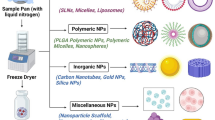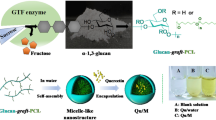ABSTRACT
Purpose
Asparagine containing peptides and proteins undergo deamidation via a succinimide intermediate. This study examines the role of the succinimide in the formation of covalent, amide-linked adducts in amorphous peptide formulations.
Methods
Stability studies of a model peptide, Gly-Phe-L-Asn-Gly, were performed in lyophiles containing an excess of Gly-Val at ‘pH’ 9.5 and 40°C/40% RH. Reactant disappearance and the formation of ten different degradants were monitored by HPLC. Mechanism-based kinetic models were used to generate rate constants from the concentration vs. time profiles.
Results
Deamidation of Gly-Phe-L-Asn-Gly in lyophiles resulted in L- and D-aspartyl and isoaspartyl-containing peptides and four amide-linked adducts between the succinimide and Gly-Val. The kinetic analysis demonstrated competition between water and terminal amino groups in Gly-Val for the succinimide. The extent of covalent adduct formation was dependent on dilution effects due to its second order rate law.
Conclusion
The cyclic imide formed during deamidation of asparagine containing peptides in lyophiles can also lead to covalent adducts due to reaction with other neighboring peptides. A reaction model assuming a central role for the succinimide in the formation both hydrolysis products and covalent adducts was quantitatively consistent with the kinetic data. This mechanism may contribute to the presence of covalent, non-reducible aggregates in lyophilized peptide formulations.






Similar content being viewed by others
REFERENCES
Manning MC, Patel K, Borchardt RT. Stability of protein pharmaceuticals. Pharm Res. 1989;6(11):903–18.
Schoneich C, Hageman MJ, Borchardt RT. Stability of peptides and proteins. In: Park K, editor. Controlled drug delivery challenges and strategies. Washington: American Chemical Society; 1997. p. 205–28.
Lai MC, Topp EM. Solid-state chemical stability of proteins and peptides. J Pharm Sci. 1999;88:489–500.
Manning MC, Chou DK, Murphy BM, Payne RW, Katayama DS. Stability of protein pharmaceuticals: an update. Pharm Res. 2010;27:544–75.
Zale SE, Klibanov AM. Why does ribonuclease irreversibly inactivate at high temperatures? Biochemistry. 1986;25:5432–44.
Costantino HR, Langer R, Klibanov AM. Solid-phase aggregation of proteins under pharmaceutically relevant conditions. J Pharm Sci. 1994;83(12):1662–9.
Nguyen TH. Oxidation degradation of protein pharmaceuticals. In: Cleland JL, Langer R, editors. Formulation and delivery of proteins and peptides. Washington: American Chemical Society; 1994. p. 59–71.
Griffiths SW, King J, Cooney CL. The reactivity and oxidation pathway of cysteine 232 in recombinant human α1-antitrypsin. J Biol Chem. 2002;277:25486–92.
Griffiths SW, Cooney CL. Development of a peptide mapping procedure to identify and quantify methionine oxidation in recombinant human a1-antitrypsin. J Chrom A. 2002;942:133–43.
Volkin DB, Klibanov AM. Thermal destruction processes in proteins involving cystine residues. J Biol Chem. 1987;262(7):2945–50.
Wu S-L, Leung D, Tretyakov L, Hu J, Guzzetta A, Wang YJ. The formation and mechanism of multimerization in a freeze-dried peptide. Int J Pharm. 2000;200:1–16.
Aswad DW. Deamidation and isoaspartate formation in peptides and proteins. Boca Raton: CRC Press; 1995.
Robinson NE, Robinson AB. Molecular clocks—Deamidation of asparaginyl and glutaminyl residues in peptides and proteins. Cave Junction: Althouse; 2004.
Wright HT. Nonenzymatic deamidation of asparaginyl and glutaminyl residues in proteins. Crit Rev Biochem Mol Biol. 1991;26:1–52.
Geiger T, Clarke S. Deamidation, isomerization, and racemization at asparaginyl and aspartyl residues in peptides. Succinimide-linked reactions that contribute to protein degradation. J Biol Chem. 1987;262:785–94.
Clarke S, Stephenson RS, Lowenson JD. Lability of asparagine and aspartic acid residues in proteins and peptides: Spontaneous deamidation and isomerization reactions. In: Ahern TJ, Manning MC, editors. Stability of Protein Pharmaceuticals Part A. New York: Plenum Press; 1992. p. 1–30.
Capasso S, Mazzarella L, Sica F, Zagon A. Deamidation via cyclic imide in asparaginyl peptides. Peptide Res. 1989;2:195–200.
Brennan TV, Clarke S. Spontaneous degradation of polypeptides at aspartyl and asparaginyl residues: effects of the solvent dielectric. Protein Sci. 1993;2(3):331–8.
Konuklar FAS, Aviyente V. Modelling the hydrolysis of succinimide: formation of aspartate and reversible isomerization of aspartic acid via succinimide. Org Biomol Chem. 2003;1(13):2290–7.
Brennan TV, Clarke S. Deamidation and iso-aspartate formation in model synthetic peptides: the effects of sequence and solution environment. In: Aswad DS, editor. Deamidation and iso-aspartate formation in peptides and proteins. Ann Arbor: CRC Press; 1995. p. 65–90.
Athmer L, Kindrachuk J, Georges F, Napper S. The influence of protein structure on the products emerging from succinimide hydrolysis. J Biol Chem. 2002;277(34):30502–7.
Capasso S, Di Cerbo P. Kinetic and thermodynamic control of the relative yield of the deamidation of asparagine and isomerization of aspartic acid residues. J Pept Res. 2000;56(6):382–7.
Li B, Borchardt RT, Topp EM, VanderVelde D, Schowen RL. Racemization of an asparagine residue during peptide deamidation. J Am Chem Soc. 2003;125(38):11486–7.
Dehart MP, Anderson BD. The role of the cyclic imide in alternate degradation pathways for asparagine-containing peptides and proteins. J Pharm Sci. 2007;96(10):2667–85.
Darrington RT, Anderson BD. The role of intramolecular nucleophilic catalysis and the effects of self-association on the deamidation of human insulin at low pH. Pharm Res. 1994;11:784–93.
Darrington RT, Anderson BD. Evidence for a common intermediate in insulin deamidation and covalent dimer formation: effects of pH and aniline trapping in dilute acidic solutions. J Pharm Sci. 1995;84:275–82.
Darrington RT, Anderson BD. Effects of insulin concentration and self-association on the partitioning of its A-21 cyclic anhydride intermediate to desamido insulin and covalent dimer. Pharm Res. 1995;12:1077–84.
Strickley RG, Anderson BD. Mechanism of degradation of human insulin in solution and solid-state between pH 2–5. Pharm Res. 1994;11(10):S-72.
Strickley RG, Anderson BD. Solid-state stability of human insulin I. Mechanism and the effect of water on the kinetics of degradation in lyophiles from pH 2–5 solutions. Pharm Res. 1996;13:1142–53.
Strickley RG, Anderson BD. Solid-state stability of human insulin II. Effect of water on reactive intermediate partitioning in lyophiles from pH 2–5 solutions—stabilization against covalent dimer formation. J Pharm Sci. 1997;86:645–53.
Li B, Gorman EM, Moore KD, Williams T, Schowen RL, Topp EM, et al. Effects of acidic N + 1 residues on asparagine deamidation rates in solution and in the solid state. J Pharm Sci. 2005;94(3):666–75.
Li B, O’Meara MH, Lubach JW, Schowen RL, Topp EM, Munson EJ, et al. Effects of sucrose and mannitol on asparagine deamidation rates of model peptides in solution and in the solid state. J Pharm Sci. 2005;94:1723–35.
Li B, Schowen RL, Topp EM, Borchardt RT. Effect of N-1 and N-2 residues on peptide deamidation rate in solution and solid state. AAPS J. 2006;8(1):E166–73.
Desfougeres Y, Jardin J, Lechevalier V, Pezennec S, Nau F. Succinimidyl residue formation in hen egg-white lysozyme favors the formation of intermolecular covalent bonds without affecting its tertiary structure. Biomacromolecules. 2011;12:156–66.
Conrad U, Fahr A, Scriba GKE. Kinetics of aspartic acid isomerization and enantiomerization in model aspartyl tripeptides under forced conditions. J Pharm Sci. 2010;99:4162–73.
Schon I, Kisfaludy L. Formation of aminosuccinyl peptides during acidolytic deprotection followed by their transformation to piperazine-2,5-dione derivatives in neutral media. Int J Pept Protein Res. 1979;14:485–95.
Sereda TJ, Mant CT, Sönnichsen FD, Hodges RS. Reversed-phase chromatography of synthetic amphipathic α-helical peptides as a model for ligand/receptor interactions. Effect of changing hydrophobic environment on the relative hydrophilicity/hydrophobicity of amino acid side-chains. J Chromatogr, A. 1994;676:139–53.
Capasso S. Thermodynamic parameters of the reversible isomerization of aspartic residues via a succinimide derivative. Thermochim Acta. 1996;286(1):41–50.
Lehmann WD, Schlosser A, Erben G, Pipkorn R, Bossemeyer D, Kinzel V. Analysis of isoaspartate in peptides by electrospray tandem mass spectrometry. Protein Sci. 2000;9(11):2260–8.
Stevenson CL, Anderegg RJ, Borchardt RT. Comparison of separation and detection techniques for human growth hormone releasing factor (hGRF) and the products derived from deamidation. J Pharm Biomed Anal. 1993;11(4–5):367–73.
Buck MA, Olah TA, Weitzmann CJ, Cooperman BS. Protein estimation by the product of integrated peak area and flow rate. Anal Biochem. 1989;182(2):295–9.
Kuipers BJ, Gruppen H. Prediction of molar extinction coefficients of proteins and peptides using UV absorption of the constituent amino acids at 214 nm to enable quantitative reverse phase high-performance liquid chromatography-mass spectrometry analysis. J Agric Food Chem. 2007;55(14):5445–51.
Mitchell J, Smith DM, Ashby EC, Bryant WMD. Analytical procedures employing Karl Fischer reagent. IX. Reactions with inorganic oxides and related compounds. Oxidation and reduction reactions. J Am Chem Soc. 1941;63:2927–30.
Patel K, Borchardt RT. Chemical pathways of peptide degradation. II. Kinetics of deamidation of an asparaginyl residue in a model hexapeptide. Pharm Res. 1990;7:703–10.
Stephenson RC, Clarke S. Succinimide formation from aspartyl and asparaginyl peptides as a model for the spontaneous degradation of proteins. J Biol Chem. 1989;264(11):6164–70.
Oliyai C, Patel J, Carr L, Borchardt RT. Solid-state stability of lyophilized formulations of an asparaginyl residue in a model hexapeptide. J Parenteral Sci Technol. 1994;48:67–173.
Lai M, Hageman MJ, Schowen RL, Topp EM. Chemical stability of peptides in polymers. 1. Effect of water on peptide deamidation in poly(vinyl alcohol) and poly(vinylpyrrolidone) matrices. J Pharm Sci. 1999;10:1073–80.
Song Y, Schowen RL, Borchardt RT, Topp EM. Effect of ‘pH’ on the rate of asparagine deamidation in polymeric formulations: ‘pH’-rate profile. J Pharm Sci. 2001;90:141–56.
Capasso S, Balboni G, Di Cerbo P. Effect of lysine residues on the deamidation reaction of asparagine side chains. Biopolymers. 2000;53:213–9.
Paranandi MV, Aswad DW. Spontaneous alterations in the covalent structure of synapsin I during in vitro aging. Biochem Biophys Res Commun. 1995;212:442–8.
Kang HJ, Coulibaly F, Clow F, Proft T, Baker EN. Stabilizing isopeptide bonds revealed in gram-positive bacterial pilus structure. Science. 2007;318:1625–8.
Wikoff WR, Liljas L, Duda RL, Tsuruta H, Hendrix RW, Johnson JE. Topologically linked protein rings in the bacteriophage HK97 capsid. Science. 2000;289:2129–33.
Dierkes LE, Peebles CL, Firek BA, Hendrix RW, Duda RL. Mutational analysis of a conserved glutamic acid required for self-catalyzed cross-linking of bacteriophage HK97 capsids. J Virol. 2009;83:2088–98.
Simons BL, King MC, Cyr T, Hefford MA, Kaplan H. Covalent cross-linking of proteins without chemical reagents. Protein Sci. 2002;11:1558–64.
Maroufi B, Ranjbar B, Khajeh K, Naderi-Manesh H, Yaghoubi H. Structural studies of hen egg-white lysozyme dimer: comparison with monomer. Biochim Biophys Acta. 2008;1784:1043–9.
Shamblin SL, Hancock BC, Pikal MJ. Coupling between chemical reactivity and structural relaxation in pharmaceutical glasses. Pharm Res. 2006;23:2254–68.
Severs JC, Froland WA. Dimerization of a PACAP peptide analogue in DMSO via asparagine and aspartic acid residues. J Pharm Sci. 2008;97:1246–56.
ACKNOWLEDGMENTS & DISCLOSURES
The authors thank the faculty at the University of Kentucky Mass Spectrometry Facility for generating the mass spectra and for their helpful discussions. Partial support for this project was provided by the H.B. Kostenbauder Endowed Professorship.
Author information
Authors and Affiliations
Corresponding author
Rights and permissions
About this article
Cite this article
DeHart, M.P., Anderson, B.D. Kinetics and Mechanisms of Deamidation and Covalent Amide-Linked Adduct Formation in Amorphous Lyophiles of a Model Asparagine-Containing Peptide. Pharm Res 29, 2722–2737 (2012). https://doi.org/10.1007/s11095-011-0591-6
Received:
Accepted:
Published:
Issue Date:
DOI: https://doi.org/10.1007/s11095-011-0591-6




